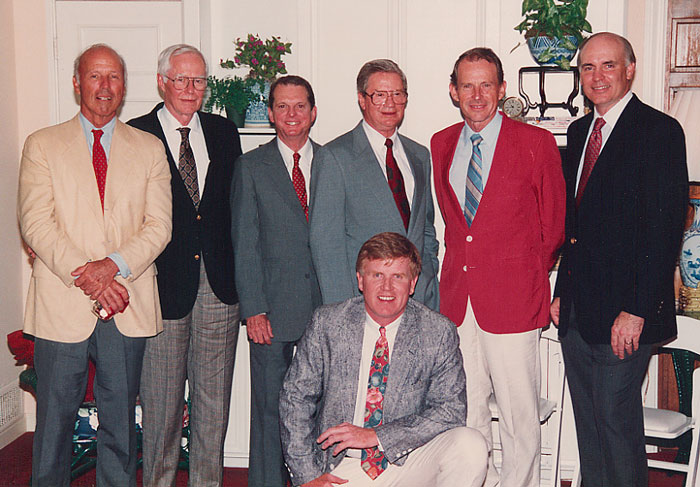- SOM
- Departments and Offices
- SOM Departments
- Surgery
- Residents
- Resources
- About Surgery at UMMC
About Surgery at UMMC
- Department of Surgery Home
- About Us
- Specialties
- Residents
- Fellows
James Harvey Hendrix Jr. Lectureship
This presentation was made by John B. McCraw, MD, professor, Division of Plastic Surgery, Department of Surgery.
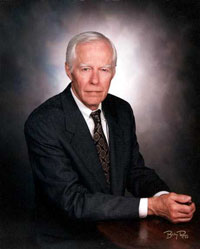 James Harvey Hendrix Jr., MD, was the first plastic surgeon in Mississippi. He was chosen by Dr. James D. Hardy to develop a Division of Plastic surgery at the new University of Mississippi Medical Center when it opened in 1955. Dr. Hendrix established the first plastic surgery residency at the University of Mississippi and later at the University of Tennessee in Memphis, eventually training two generations of plastic surgeons.
James Harvey Hendrix Jr., MD, was the first plastic surgeon in Mississippi. He was chosen by Dr. James D. Hardy to develop a Division of Plastic surgery at the new University of Mississippi Medical Center when it opened in 1955. Dr. Hendrix established the first plastic surgery residency at the University of Mississippi and later at the University of Tennessee in Memphis, eventually training two generations of plastic surgeons.
Dr. Hendrix is a native of Newbern, TN, where he was valedictorian of his high school class. Dr. Hendrix attended the University of Tennessee in Knoxville, followed by the University of Tennessee College of Medicine in Memphis, where he was elected to membership into the Alpha Omega Alpha Honorary Society. Dr. Hendrix was an intern at the Methodist Hospital in Memphis, just before serving in the Army from 1944-46. He returned from the war to Galveston, TX, to complete his plastic surgery training, and he then completed his general surgery training at the Baptist Memorial Hospital in Memphis.
Dr. Hendrix has always been a respected leader. He served as chief of the Department of Surgery and president of the medical staff at the Mississippi Baptist Hospital in Jackson, MS. He served as consultant in plastic surgery to the U.S. Air Force Hospital, Keesler Field, in Biloxi, MS, consultant in plastic surgery to the St. Jude Children's Research Hospital in Memphis, and consultant in plastic surgery to the Tennessee Cripple Children's Service. Dr. Hendrix was one of the leading figures in the second generation of plastic surgeons, serving on the Residency Review Committee, the Advisory Council for Plastic and Maxillofacial Surgery for the American College of Surgeons, and the American Board of Plastic Surgery.
Dr. Hendrix has been honored by his peers with elections to chairman of the Plastic Surgery Council, president of the Aesculapian Society, historian of the American Association of Plastic Surgeons, president of the Southeastern Society of Plastic and Reconstructive Surgeons, president of the Clinical Society of University Plastic Surgeons, and president of the American Society of Plastic and Reconstructive Surgeons. As president of the largest plastic surgery organization in the world, Dr. Hendrix was known for his gentlemanly approach to the difficult problems of this new surgical specialty. Dr. Hendrix received the prestigious Kenneth Pickrell Award from the Southeastern Society of Plastic and Reconstructive Surgeons, awarded for his accomplishments as a teacher and surgical educator. Dr. Hendrix has contributed extensively to the plastic surgery literature, and he has made numerous presentations throughout the southeastern states.
"Jimmy," as he is known to his friends, is remembered for his quick smile, his serious frown, his honesty and his integrity. Because he is one of the kindest human beings ever to walk this earth, Dr. Hendrix was loved by all of his co-workers. He is one of the great men of plastic surgery in the 20th century.
Reflections of a Hendrix resident
At the inaugural meeting of the James Harvey Hendrix Society on January 18, 2002, Dr. William Bobo Thompson, a Hendrix resident, presented the following tribute to his chief.
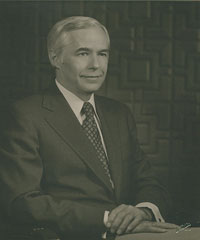 From 1972-74, it was my great privilege to be a resident with Dr. Hendrix in Memphis. The years have gone by, and now I have become the senior partner in the clinic that he established here in 1952. He was the first plastic surgeon in our state and the first chief of the residency program here. Dr. Hendrix laid the foundation for plastic surgery in Mississippi, and, in a real sense, he contributed to the professional opportunities enjoyed by everyone here today. He was the chief here until 1972, when he moved to Memphis to take over the University of Tennessee program. During his tenure at the two programs, he trained about 40 plastic surgeons.
From 1972-74, it was my great privilege to be a resident with Dr. Hendrix in Memphis. The years have gone by, and now I have become the senior partner in the clinic that he established here in 1952. He was the first plastic surgeon in our state and the first chief of the residency program here. Dr. Hendrix laid the foundation for plastic surgery in Mississippi, and, in a real sense, he contributed to the professional opportunities enjoyed by everyone here today. He was the chief here until 1972, when he moved to Memphis to take over the University of Tennessee program. During his tenure at the two programs, he trained about 40 plastic surgeons.
I think that it is well known that those of us who were fortunate enough to be his residents share a common bond of deep admiration and respect for our chief. For me, these feelings have been reaffirmed countless times over the years by the comments of his patients, colleagues, and friends. One of the most frequent compliments I have heard is that he has always been, in every respect, a gentleman, and that is the thought that emerges as I reflect on being a Hendrix resident.
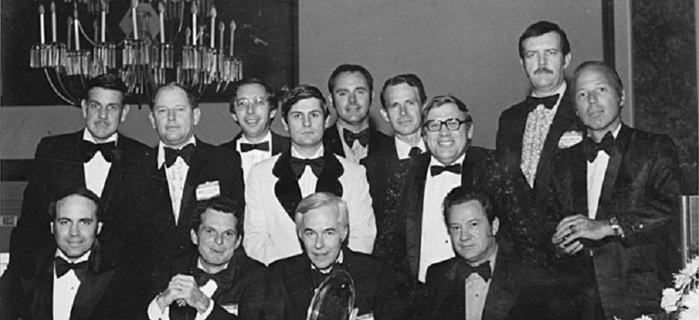
Seated in the front row from left to right are: William Bobo Thompson of Jackson, Byron Green of Mobile, Dr. Hendrix, and Heber Ethridge, of Jackson. In the second row, standing from left to right, are Bill Garry, of Dallas, Bob Love, of Greenville, Howard Kisner, of Baton Rouge, Frank Newman of Kalamazoo, and Gordon Robinson of Birmingham. In the back row are the late Will Noblin of Montgomery, Byron Brown of Dallas, Doug Godfrey of Jackson, and Charlie White of Memphis.
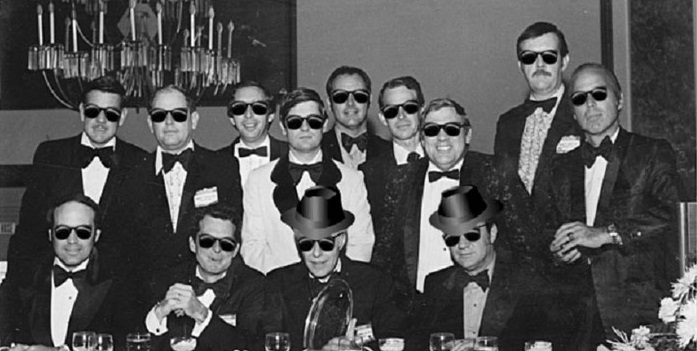
This picture was made at the ASPRS meeting in Houston in 1974 when Dr. Hendrix was the president and took time to share the moment with a group of his former residents. In those days, the Chief was perceived as an easy-going, low-key kind of guy, but there were some things he was not really laid-back about. Plastic surgery was one of them. Although we residents clearly enjoyed being around him, I believe that it was his quiet passion for his profession, as much as anything, that drew us in. I think that this picture captures that spirit to some extent.
It reminds me of the Blues Brothers Band. Like Elwood Blues in the movie, the Chief was on a "mission from God," and we were all like members of the band.
Blues Brothers or not, pictured here are men of serious leadership qualities as well as surgical ability. Heber Ethridge, Dr. Hendrix's first resident and his first partner, led the residency through times when there was no full-time chief of plastic surgery. Doug Godfrey, the Chief's second partner, was a major contributor to the teaching program in Mississippi, as was Charlie White in Memphis. Charlie eventually succeeded Dr. Hendrix as chief in Memphis. Incidentally, Charlie really did play in a jazz band. I can proudly say that I knew Charlie when he was a saxophone player by night and a rat surgeon by day (Charlie spent a year in the research lab before starting his residency). Bob Love has made a major contribution to our state as founder and director of the burn center at Greenville. There are three past presidents of the Southeastern Society of Plastic Surgeons in the picture: Dr. Hendrix, Byron Green, and Howard Kisner. Howard gets the "best dressed dude" award for the sweet, powder blue dinner jacket he had on in the picture.
All of the guys in this picture trained in Jackson except for me. Howard was the transition resident. He did his first year here and his second year in Memphis. I was the junior resident that first year in Memphis.
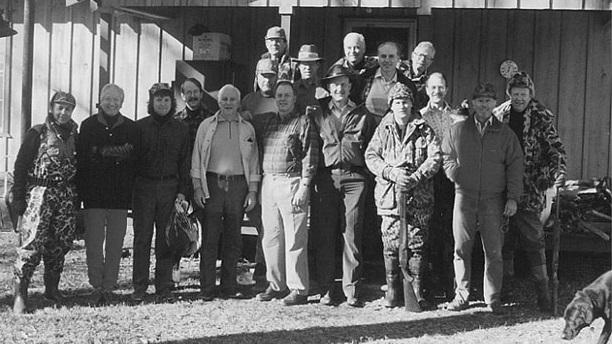 Here is Howard Kisner (front row, second from right) and some other plastic surgeons defending Stuttgart, Arkansas, against a duck attack. Among the group are several other Hendrix men including Gordon Robinson (front row, right), myself (second row, third from right), Jim Beckman (back row, left), and George Burruss (second row, left). The Chief wasn't present for this picture because he had gone to another nearby hunt, but he was the one who got us into the Arkansas Duck Hunt and Reconstructive Surgery Symposium. The Chief was a good shot, but we used to tease him mercilessly for an alleged tendency to shoot spoonbills, a particularly inedible species of duck.
Here is Howard Kisner (front row, second from right) and some other plastic surgeons defending Stuttgart, Arkansas, against a duck attack. Among the group are several other Hendrix men including Gordon Robinson (front row, right), myself (second row, third from right), Jim Beckman (back row, left), and George Burruss (second row, left). The Chief wasn't present for this picture because he had gone to another nearby hunt, but he was the one who got us into the Arkansas Duck Hunt and Reconstructive Surgery Symposium. The Chief was a good shot, but we used to tease him mercilessly for an alleged tendency to shoot spoonbills, a particularly inedible species of duck.
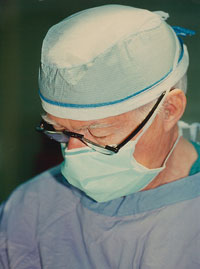 The Chief was a gentleman inside the operating room as well as out. I never heard him use profanity in the operating room, although I can't be sure that a little slip didn't occur now and then. I can say that I never saw him lose his cool in surgery. The OR personnel seemed to knock themselves out to have everything just like he wanted.
The Chief was a gentleman inside the operating room as well as out. I never heard him use profanity in the operating room, although I can't be sure that a little slip didn't occur now and then. I can say that I never saw him lose his cool in surgery. The OR personnel seemed to knock themselves out to have everything just like he wanted.
Someone once said, "The mark of a great man is how he treats people he doesn't have to be nice to." The Chief definitely passed that test. As a rule, he was pretty quiet in the OR, but, whether he said much or not, scrubbing with Dr. Hendrix was always instructive. He was a meticulous surgeon who, as everyone knows, got beautiful results.
I think that plastic surgery appeals to the creative side of us - the art as well as the science of surgery. Certainly, no one did it better than the Chief. For many of us, it was a lecture he gave or a procedure that we saw him do that sparked the inner fire, and we knew that's what we wanted to do. It happened over and over again to students and residents who rotated on the service.
Most of us trained with Dr. Hendrix at a time when the distinction between private and house service patients was much sharper than it is now. Prior to his arrival, the program in Memphis was basically a cosmetic surgery preceptorship centered at Baptist Hospital. There were strong ENT, oral surgery, and orthopedic departments, so Howard and I had to work hard to establish clinics and services at John Gaston Hospital, which was the University Hospital, and at the VA. In the process, some turf battles with other services inevitably arose, but most frustrating was the hospital itself.
Like most public hospitals, John Gaston could be unkind to its residents. A good example was my experience at the end of one long day when I came out to my car and found all four tires deflated and a note on the windshield that said, "Don't park here no more." Apparently, I had parked in the wrong lot. In spite of the obstacles, though, we made considerable progress that first year. We eventually established constructive relationships with the other services and developed a busy plastic surgery clinic.
The Chief encouraged us to do research, and we did. However, not all of our projects turned out so well. One of mine that ended abruptly one night when some pigs on which I was doing research got too big and broke out of their cages. They stampeded through the vivarium, and basically, tore the place up. The Chief was known as a patient man, and I am sure I was not the first resident to test his limit. But I think it is safe to say that I am the only one with a pig stampede on his record.
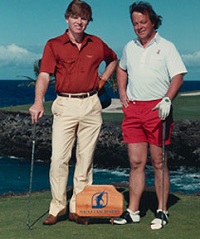
Here are Robert Allen Smith and Garnett Murphy in Hawaii. The word was that if you planned to go on a trip with these guys, you should allow an extra day for the possibility that you might end up in jail. They really knew how to have a good time.
They also knew how to do surgery. Garnett and Robert Allen came into the residency in Memphis just as I was finishing and with skill and effort, raised the program to a new level.
Here is a more recent picture of some of the same perpetrators with the Chief on the occasion of Heber Ethridge's retirement. I wish I had pictures of all of the Hendrix residents because I know that
Here is a more recent picture of some of the same perpetrators with the Chief on the occasion of Heber Ethridge's retirement. I wish I had pictures of all of the Hendrix residents because I know that each one is as important to him as the other. But, I think I've shown a representative sampling, and I hope I've conveyed something of our spirit and our relationship to the Chief. When you think about it, the evolution of our specialty since Dr. Hendrix came to Mississippi has been truly remarkable. I would not want to end these remarks without acknowledging the contributions of all who have come after him, especially those of the past and present plastic surgery faculty here at the University. Certainly, no one is prouder of their accomplishments than the Chief and his former residents; but, I think we will all agree that Jimmy Hendrix, the surgeon and the gentleman, has been a hard act to follow.
